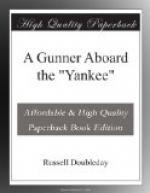“‘For heaven’s sake, hurry up!’ said the division officer, getting nervous.
“‘In a minute, sir,’ said Bill. ‘As soon as I get a good bead.’
“He was as cool as an ice machine, and as deliberate as an old hen, but he could shoot, so we held ourselves in as best we could and watched. After waiting for what seemed an hour, Bill pulled the lanyard and the old gun roared. As soon as the smoke cleared away, we looked to see the result of the shot. There was some wreckage floating where the torpedo boat had been—that was all. Bill’s shot went home, and exploded in the boiler room, and the whole craft went up in an instant.”
We looked again admiringly at the man sitting there so unconcernedly, and then in obedience to the boatswain’s call, went aft and aboard our cutter.
All the ammunition for the fleet was unloaded by Tuesday. We still carried a small quantity of both powder and shell for the “Massachusetts.”
Tuesday afternoon we anchored alongside the sailing collier “Frank A. Palmer,” and began to coal. The “Yankee’s” sister ship “Prairie,” manned by the Massachusetts Naval Reserves, lay on the other side; we exchanged visits and found them good fellows, and we yarned away to our heart’s content.
We had now become, in a degree, used to coaling; our muscles were hardened and some long-needed labor-saving devices had been introduced, so the work was a little easier.
Coaling continued till Friday night. During the morning of that day we were told that if two hundred tons were put aboard, a chance would be given us on the morrow to see the wrecks of Cervera’s once fine vessels. It was all the incentive we needed, and the coal came aboard in a steady stream. A little after seven the required amount was in the bunkers, and by eight o’clock the stages and other coaling paraphernalia were stowed away and the “Yankee” had cast loose and was anchored by herself.
The following morning dawned bright and clear. Admiral Sampson came aboard at 8:30. We manned the “cat falls” and got under way at once.
On the way down to the wrecks, the ship was cleaned, so by the time we reached the ruins of the Spanish vessels, the “Yankee” was spick and span.
We passed the wrecks of the two torpedo boats, passed the mouth of Santiago harbor, till finally we came to the “Almirante Oquendo” and the “Maria Teresa,” fifteen miles west of old Morro.
The two wrecks lay close together. They were a melancholy sight; the “Almirante Oquendo,” badly listed to port, a great rent in her side, rusted, almost completely demolished. The “Maria Teresa” seemed in better shape, but many shot holes were visible in her side.
It was a dreary though gratifying sight. The great green-clothed mountains looked down serenely on these two examples of man’s handiwork and man’s destructiveness; the blue sea dashed itself to foam against the coral-bound coast; and the bright sun shone over all.




